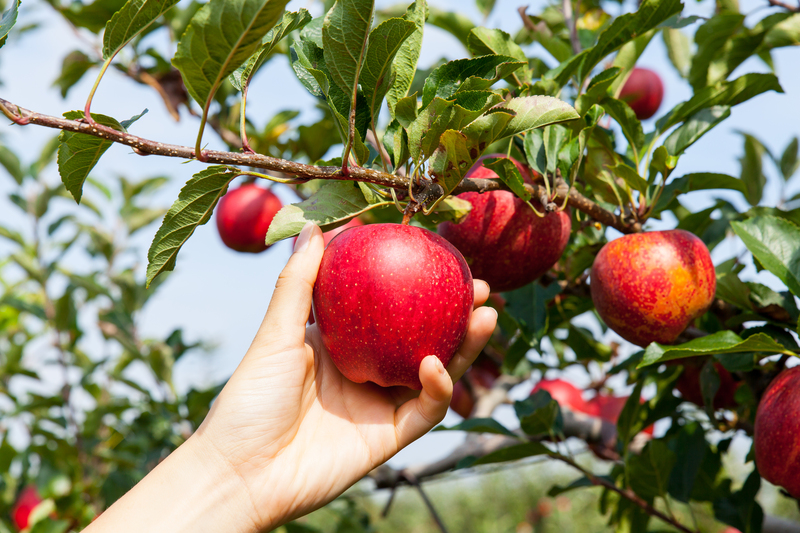Proven Methods to Tackle Unwanted Weeds
Posted on 05/09/2025
Proven Methods to Tackle Unwanted Weeds
Unwanted weeds are a persistent problem faced by gardeners, homeowners, and landscapers worldwide. Whether you're cultivating a vegetable patch, maintaining a lush lawn, or simply trying to keep your pathways clear, weed control is essential. Left unchecked, these intruders can steal nutrients, obstruct sunlight, and sap moisture from your desired plants. Fortunately, there are several tested and proven strategies for eliminating and managing unwanted weeds efficiently and sustainably.


Understanding Unwanted Weeds: The Basics
Before diving into the most effective techniques for weed management, it's important to identify what weeds are and why they thrive. Technically, a weed is any plant growing where it isn't wanted. These unwanted guests often exhibit rapid growth, exceptional resilience, and prolific seed production.
- Annual weeds: Complete their lifecycle in one season (e.g., crabgrass, chickweed).
- Perennial weeds: Live for multiple years and spread via underground roots or rhizomes (e.g., bindweed, dandelion).
- Biennial weeds: Take two years to complete their lifecycle (e.g., burdock, wild carrot).
Knowing your enemy is the first step to choosing the right weed removal method. Let's explore the proven ways to handle unwanted weeds.
Manual Weed Removal Methods
Hand Pulling
Hand-pulling remains one of the oldest and most effective ways to tackle unwanted weeds, particularly for smaller infestations. This method is simple, eco-friendly, and requires no chemicals.
- When to use: Ideal for annual weeds and after rain when the soil is moist.
- How to do it right: Grasp the weed firmly at the base and pull it out slowly, ensuring the entire root system is removed.
- Tools that help: Dandelion diggers, weeding knives, and short-handled hoes.
Hoeing and Cultivation
A sharp hoe is an invaluable tool for disrupting young weed seedlings. Running a hoe just beneath the soil's surface will cut weeds off at their roots, causing them to quickly desiccate and die.
- Advantages: Efficient for large areas and for controlling tender seedlings before they mature.
- Pro tip: Hoe early and often. Frequent, shallow hoeing prevents new weeds from taking hold.
Mulching Techniques
Mulching is a tried-and-true method for suppressing unwanted plant growth while retaining soil moisture and improving soil quality.
- Organic mulches: Straw, wood chips, shredded bark, compost, grass clippings.
- Inorganic mulches: Landscape fabric, black plastic, gravel.
- Effectiveness: Mulch limits light reaching weed seeds, drastically reducing germination.
Apply a layer 2-4 inches thick for maximum suppression, renewing it as material breaks down.
Natural and Organic Weed Control Strategies
For those striving for an organic garden or eco-friendly landscape, non-chemical methods are a priority. Thankfully, there are several proven organic ways to get rid of unwanted weeds:
Solarization
Solarization involves using the sun's heat to kill weeds and their seeds. It works exceptionally well in sunny climates and for preparing beds for new plantings.
- Moisten the soil and cover affected area with clear plastic sheeting.
- Seal the edges to trap heat.
- Leave the plastic in place for 4-6 weeks during the hottest part of the year.
Soil temperatures can rise high enough to destroy weed seeds, pathogens, and even some pests.
Boiling Water and Vinegar Treatments
- Boiling water: Pour directly onto leafy weeds. The extreme heat instantly wilts them. Take care to avoid desirable plants.
- Vinegar sprays: Household vinegar (5% acetic acid) or stronger horticultural vinegar works as a contact herbicide on young weeds. Spray on a sunny day for best results.
These remedies offer a quick fix, especially for weeds in cracks and walkways, but may need repeated applications.
Homemade Weed Barriers
A durable and sustainable way to prevent weed growth in garden beds is by using homemade barriers:
- Old newspapers or cardboard laid under mulch
- Burlap or recycled fabric sheets
- Thick layers of leaf mold
Such barriers smother seedlings and reduce light penetration, making gardens less hospitable to unwanted growth.
Selective Use of Chemical Weed Killers
While non-chemical approaches are generally safer for the environment, chemical herbicides can sometimes be the most practical option for large-scale or persistent weed invasions. Modern weed killers come in two main categories:
- Selectives: Target specific weed types (e.g., broadleaf or grassy weeds) while sparing turfgrass or crops.
- Non-selectives: Kill any green plant tissue they contact. Glyphosate-based products are common examples.
Tips for responsible use:
- Apply only as a last resort, following label directions exactly.
- Avoid spraying on windy days to prevent drift onto desired plants.
- Always wear appropriate protective clothing (gloves, masks, eyewear).
If you prefer a less toxic option, seek out organic-approved herbicides based on fatty acids, essential oils, or iron-based compounds. They are friendlier to soil life and pets.
Preventing Weed Infestations
Prevention is always easier than cure. Follow these integrated weed prevention methods to keep weeds from becoming a major problem:
Dense Planting and Cover Crops
A thick canopy of desirable plants leaves little room for weed seeds to germinate. Consider:
- Interplanting vegetables or flowers closely
- Sowing fast-growing groundcovers
- Utilizing winter cover crops (like clover or ryegrass) to occupy bare soil
These natural weed control solutions limit light and space, outcompeting weeds organically.
Regular Lawn Maintenance
A healthy, lush lawn is its own best defense. Here's how to naturally suppress weeds in turf areas:
- Keep grass at recommended mowing height; never cut more than one-third at a time.
- Feed and water properly to encourage vigorous growth.
- Rake up thatch and aerate soil annually to reduce compaction.
- Overseed thin spots each fall to crowd out unwanted invaders.
Proper Mulch and Edging Practices
Apply fresh mulch and use physical edging around beds, patios, and pathways. Edging creates a physical barrier to creeping weeds such as Bermuda grass or bindweed.
Timing and Consistency: The Keys to Successful Weed Control
All successful weed eradication efforts rely on timing and determination. It's far easier to remove weeds before they set seed or develop strong root systems.
- Inspect your garden weekly and address weeds when they're small.
- Never let weeds go to seed; a single plant can produce thousands of seeds each season.
- Use a combination of methods (mechanical, organic, and preventative) for long-term success.
Common Mistakes to Avoid When Battling Weeds
To maximize your efforts, be aware of these pitfalls:
- Ignoring weed growth until infestations become severe.
- Poor mulching techniques, such as using too thin a layer or the wrong material.
- Overwatering, which can encourage both plant and weed growth.
- Using contaminated compost or soil that contains weed seeds.
- Relying solely on chemical weed killers, which can lead to resistance and harm beneficial insects.
Eco-Friendly & Sustainable Weed Management
Gardeners increasingly seek environmentally responsible weed control methods. Here's how to promote a healthier backyard ecosystem:
- Use natural mulch or living ground covers instead of synthetic fabrics or plastics.
- Encourage soil health through composting, crop rotation, and gentle cultivation.
- Attract weed-eating insects and birds by creating habitat diversity.
- Employ hand weeding near pollinator plants to protect beneficial insects.
Frequently Asked Questions about Unwanted Weed Removal
Is hand-weeding always effective?
Hand-weeding is very effective for small-scale infestations, especially when roots are fully removed. For deep-rooted perennials, try using a long-bladed digging tool.
How often should I mulch to control weeds?
Refresh mulch at least once per growing season, or as soon as thinning is visible. Maintain a 2-4 inch layer for best weed prevention.
Are organic herbicides safe for pets?
Many organic herbicides made from vinegar, fatty acids, or essential oils are safer than synthetics for pets and wildlife, but some can still irritate paws or skin. Always verify with the product label.
What's the fastest way to kill weeds between pavers?
Pouring boiling water or spraying vinegar directly on weeds is quick and effective for hard surfaces. Sweep away dead material to prevent regrowth.
Final Thoughts: Achieving a Weed-Free Garden
Tackling unwanted weeds is an ongoing process that combines persistence, know-how, and multiple strategies. By integrating proven weed control methods--ranging from hand-pulling and mulching, to selective chemical controls and eco-friendly alternatives--you can reclaim your garden, lawn, or landscape from invasive weeds.
The key is to tailor your approach to your own yard, climate, and gardening philosophy. A little time invested each week makes all the difference between a weed-choked patch and a flourishing oasis. Consistency, vigilance, and a willingness to experiment with various weed suppression techniques will secure you lasting results and a more enjoyable outdoor space.
For further information on the best ways to remove unwelcome weeds and maintain a vibrant yard, consult reputable gardening resources, extension services, or local experts. Your battle with weeds can be won--with the right methods and a little determination.



